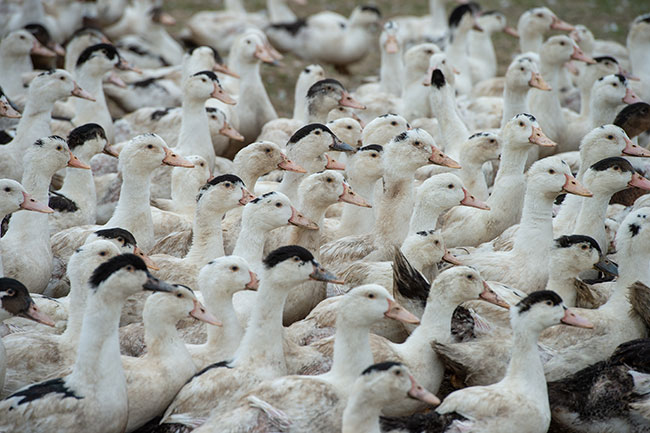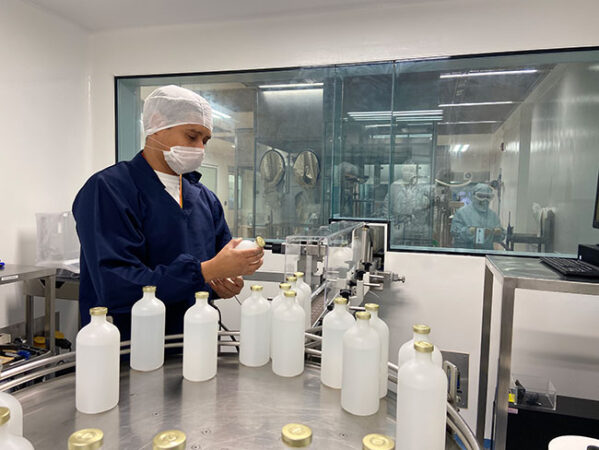
France Defies Trade Fallout: Ducks vaccinated against H5N1 amidst global crisis
By Melanie Epp
Features Disease watchFrance became the first Western nation to vaccinate birds against avian influenza despite threat of trade restrictions. Here are exclusive insights into challenges, strategies, and the uncertain future of avian influenza control.
 In France, vaccination is now mandatory for ducks on farms with more than 250 birds whose products are meant to be sold as either foie gras or as meat.
PHOTO: Esperanza33 / getty Images
In France, vaccination is now mandatory for ducks on farms with more than 250 birds whose products are meant to be sold as either foie gras or as meat.
PHOTO: Esperanza33 / getty Images A persistence of a particularly virulent strain of H5N1 highly pathogenic avian influenza (HPAI) has been circling the globe since 2021, debilitating poultry production systems around the world. In France, most of the outbreaks have occurred in poultry-dense regions.
During the 2021–2022 outbreaks, nearly 20 million birds were lost, and economic losses reached more than $700 million. Once the cost of culling infected flocks and enhancing biosecurity is factored in, the total price tag is closer to $1.5 billion.
In October 2023, France began vaccinating ducks – the most susceptible poultry – against avian influenza. It is the first Western nation to adopt such a program, despite the threat of trade restrictions.
Vaccination program kicks off
France’s decision to vaccinate did not come easy. The country brought the subject forward at a European Commission meeting in 2022.
After much discussion, the Commission published a set of rules around vaccination in February 2023. EU member states were given authorization to begin vaccinating against the virus. The decision to do so was left up to the individual member states. The process, the Commission said, would be strictly monitored.
France’s poultry sector, under the guidance of the ministry of agriculture, made the decision to go forward with a vaccination campaign early this spring. Initially, it is focused on France’s most vulnerable poultry market: ducks.
Ducks were chosen because they are more susceptible to avian influenza than other poultry species, and their level of excretion is much higher.
According to Yann Nedelec, director of ANVOL, the interprofessional poultry association, duck producers welcomed the decision. ANVOL represents producers of ducks for consumption, approximately 30 to 35 million ducks or 50 per cent of the duck industry in France. The remaining 50 per cent are produced for the foie gras sector. Duck production accounts for just eight per cent of total poultry production in France.
Currently, vaccination is mandatory for ducks on farms with more than 250 birds whose products are meant to be sold as either foie gras or as meat. In total, some 64 million ducks on over 2,700 farms will need to be vaccinated. The campaign will cost nearly $150 million, of which 85 per cent is to be footed by the French government.

The Boehringer Ingelheim vaccine production unit is providing the 80 million doses needed for vaccination from October 1, 2023 to April 1, 2024.
PHOTO: Boehringer-Ingelheim
Trade restrictions announced
Immediately following France’s decision to begin vaccinating ducks, both Canada and the U.S. announced trade restrictions. Of the two countries, the U.S. took the much stricter stance. Immediately following the announcement, the U.S. Department of Agriculture suspended all poultry imports from France and the EU. Currently, it does not allow the importation of poultry from countries affected with HPAI, nor from flocks that have been vaccinated against HPAI.
Since EU member states and other European countries have open access to the European common market for trade in poultry commodities, the USDA extended the restrictions to include member states that fall within the European Poultry Trade Region (EPTR). Their reasoning is that authorities cannot be certain from where poultry products originate, which means there’s increased risk of introducing HPAI infections to the U.S.
The Canadian government also suspended poultry imports from France, but did not extend that suspension to the rest of the EPTR. In a recent interview, the Canadian Food Inspection Agency (CFIA) said it has engaged with authorities in France and is conducting an assessment to evaluate the potential risks of the vaccination campaign.
Since the risk assessment is still underway, CFIA decided to implement the temporary measure, effective as of October 1. The measure suspends the importation of all live poultry, hatching eggs, and raw fresh and frozen poultry products originating from France.
“This is necessary, as the CFIA must evaluate any risks posed by these imports on Canadian public health, animal health, the poultry industry, as well as any secondary trade implications for poultry and poultry products exported from Canada,” the agency said in an email.
Task force considers vaccination
In the meantime, the assembled task force – a team of experts that includes veterinarians and academia, as well as industry and government representatives – will discuss issues relating vaccination. The task force will serve as a forum for discussion, information-sharing and consensus building on an approach to HPAI vaccination in Canada.
A CFIA spokesperson said the group is exploring the use of vaccines based on scientific research, international trade and disease control considerations. Topics of discussion include: the availability of effective vaccines; ability to distinguish vaccinated and unvaccinated birds; implementation considerations; approaches to surveillance; and trade implications, among others.
Shayan Sharif, a University of Guelph professor whose research is focused on the chicken immune system and avian influenza, is one of the members of the task force. There are several layers of complexity around vaccination that first need to be thoroughly explored before a decision can be made, said Sharif.
“Are we vaccinating to protect poultry from disease?” he said. “Or are we vaccinating to reduce the amount of transmission of the virus? And would there be any trade consequences, and would we be able to mitigate the risk of trade consequences?”
Post-vaccination strategy
For now, the answers to these questions are unknown. One thing is clear, though: a post-vaccination strategy will be necessary. “There’s going to have to be a major surveillance activity post vaccination to ensure, if you vaccinate, that these vaccinated birds are not going to become silent carriers of the virus,” Sharif says.
The EU has very strict rules around the monitoring of vaccinated flocks. This is to ensure that, as Sharif points out, the virus doesn’t silently circulate. “It is quite complicated,” ANVOL’s Nedelec says. “They are very heavy measures to put in place.”
Not only are the regulations complicated, but the rigorous surveillance programs that track the vaccine’s effectiveness are costly. Thomas Delquigny, veterinarian and avian technical manager at Boehringer-Ingelheim, says just 25 per cent of the total cost to vaccinate is represented by the vaccination itself. The rest of the costs go towards surveillance, certification, sampling and analysis.
The French government chose to authorize just one vaccine. It was developed by Boehringer-Ingelheim. Delquigny says it was selected because the company showed it was the most effective option for protecting flocks from infection and reducing expression of the virus in the environment.
The sub-unit vaccine contains one part of the H5 virus. It is administered via injection. Two injections are required to complete the cycle, the first at 10 days and the second at 28 days.
According to a recent Reuters article, only 70 per cent of ducks in France have received their first injection; 40 per cent are fully vaccinated. France reported its first outbreak of avian influenza on a turkey farm in Brittany in late November. The poultry sector will be watching closely to see if the vaccination program will prove effective.
But even if the program proves successful, producers will still need to remain vigilant when it comes to biosecurity. “It’s going to be a tool in the toolbox,” says Sharif, referring to the vaccine. “It can’t be used for every farm, and it shouldn’t be used for every farm.
“Producers have done a really good job protecting their flocks,” he adds. “My kudos to them.”
Avian influenza outbreak by the numbers
After the Poultry Industry Services Workshop this past fall, cases of avian influenza were on the rise again in Western Canada. Here’s where things stood as of November 2, 2023, according to data from the Canadian Food Inspection Agency (CFIA) website.
- December 20, 2021 Is when CFIA confirmed the presence of HPAI, subtype H5N1, in a small flock in Newfoundland, marking the start of the ongoing situation.
- 7.9 million is how many poultry birds have been impacted
by avian influenza in Canada this year. - British Columbia has the highest number of birds impacted, followed by Alberta and Quebec.
- 800 is the number of people that have contracted H5N1
since 1997, making it extremely rare in humans. - 2,500 is the number of wild birds that have tested positive or are suspected to be positive for avian influenza since late-2021, according to the Canadian Wildlife Health Cooperative.
Print this page